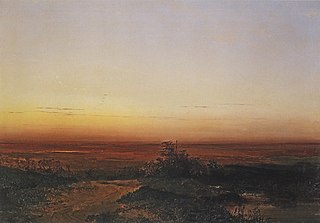
Semele, or Thyone in Greek mythology, was the youngest daughter of Cadmus and Harmonia, and the mother of Dionysus by Zeus in one of his many origin myths.

Dievturība is a modern continuation of the ethnic religion of the Latvians from what it was before Christianization in the 13th century. Adherents call themselves Dievturi, literally "Dievs' keepers", "people who live in harmony with Dievs". The movement is mainly based on Latvian folklore, folk songs and Latvian mythology.
Laima is a Baltic goddess of fate. She was associated with childbirth, marriage, and death; she was also the patron of pregnant women. Laima and her functions are similar to the Hindu goddess Lakshmi.
Latvian mythology is the collection of myths that have emerged throughout the history of Latvia, sometimes being elaborated upon by successive generations, and at other times being rejected and replaced by other explanatory narratives. These myths, for the most part, likely stem from Proto-Indo-European practices and the later folk traditions of the Latvian people and pre-Christian Baltic mythology.
In Latvian mythology, the term Māte stands for "mother", sometimes written in English as Mahte. It was an epithet applied to some sixty-seventy goddesses. They were clearly distinct goddesses in most or all cases, so the term definitely referred to the mother-goddess of specific phenomena. According to professor Lotte Motz, scholar Haralds Biezais mentioned there were at least 70 characters in Baltic religion identified with the title of Mate.
Auseklis is a Latvian god, a stellar deity that represents a celestial body, but possibly not the same as Venus - the first "star" to appear in the mornings on the east side of the sky. He is the third most popular deity in Latvian mythology after Saulė and Mēness, but is almost exclusively mentioned in folk songs.

Proto-Indo-European mythology is the body of myths and deities associated with the Proto-Indo-Europeans, speakers of the hypothesized Proto-Indo-European language. Although the mythological motifs are not directly attested – since Proto-Indo-European speakers lived in preliterate societies – scholars of comparative mythology have reconstructed details from inherited similarities found among Indo-European languages, based on the assumption that parts of the Proto-Indo-Europeans' original belief systems survived in the daughter traditions.

A daina or tautas dziesma is a traditional form of music or poetry from Latvia. Lithuanian dainos share common traits with them, but have been more influenced by European folk song traditions. Latvian dainas often feature drone vocal styles and pre-Christian themes and legends, and can be accompanied by musical instruments such as Baltic psalteries . Dainas tend to be very short and are usually in a trochaic or a dactylic metre. Dainas are being translated into English by Latvian American Ieva Auziņa-Szentivanyi.
Lithuanian mythology is the mythology of Lithuanian polytheism, the religion of pre-Christian Lithuanians. Like other Indo-Europeans, ancient Lithuanians maintained a polytheistic mythology and religious structure. In pre-Christian Lithuania, mythology was a part of polytheistic religion; after Christianisation mythology survived mostly in folklore, customs and festive rituals. Lithuanian mythology is very close to the mythology of other Baltic nations – Prussians, Latvians, and is considered a part of Baltic mythology.
Aušrinė is a feminine deity of the morning star (Venus) in the Lithuanian mythology. She is the antipode to "Vakarinė", the evening star.

Saulė is a solar goddess, the common Baltic solar deity in the Lithuanian and Latvian mythologies. The noun Saulė/Saule in the Lithuanian and Latvian languages is also the conventional name for the Sun and originates from the Proto-Baltic name *Sauliā > *Saulē.

Žemyna is the goddess of the earth in Lithuanian religion. She is usually regarded as mother goddess and one of the chief Lithuanian gods similar to Latvian Zemes māte. Žemyna personifies the fertile earth and nourishes all life on earth, human, plant, and animal. All that is born of earth will return to earth, thus her cult is also related to death. As the cult diminished after baptism of Lithuania, Žemyna's image and functions became influenced by the cult of Virgin Mary.
Perkūnas was the common Baltic god of thunder, and the second most important deity in the Baltic pantheon after Dievas. In both Lithuanian and Latvian mythology, he is documented as the god of sky, thunder, lightning, storms, rain, fire, war, law, order, fertility, mountains, and oak trees.

*H₂éwsōs or *Haéusōs is the reconstructed Proto-Indo-European name of the dawn goddess in the Proto-Indo-European mythology.

Latvian Lauma or Lithuanian Laumė, or Yotvingian Łauma is a fairy-like woodland spirit, and guardian spirit of orphans in Eastern Baltic mythology or Yotvingian mythology. Originally a sky spirit, her compassion for human suffering brought her to earth to share our fate.
Baltic mythology is the body of mythology of the Baltic peoples stemming from Baltic paganism and continuing after Christianization and into Baltic folklore.
Lithuanian Dievas, Latvian Dievs and Debestēvs (Sky-Father), Latgalian Dīvs, Old Prussian Dìews, Yotvingian Deivas was the primordial supreme god in the Baltic mythology, one of the most important deities together with Perkūnas, and the brother of Potrimpo. He was the god of light, sky, prosperity, wealth, ruler of gods, and the creator of the universe. Dievas is a direct successor of the Proto-Indo-European supreme sky father god *Dyēus of the root *deiwo-. Its Proto-Baltic form was *Deivas.
*Dʰéǵʰōm, or *Pl̥th₂éwih₂, is the reconstructed name of the Earth-goddess in the Proto-Indo-European mythology.








